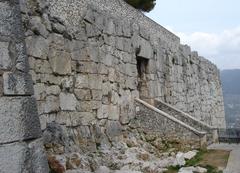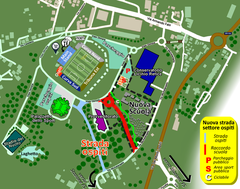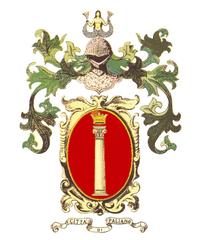Rome Fiuggi Railway Visiting Hours, Tickets, and Travel Guide
Date: 15/06/2025
Introduction to the Rome–Fiuggi Railway
The Rome–Fiuggi Railway stands as a remarkable example of early 20th-century innovation, shaping the Lazio region’s economic, social, and cultural landscape. Originally built to connect Rome with the spa town of Fiuggi and the broader Ciociaria area, this narrow-gauge electric railway reflected Italy’s modernization ambitions. Operational between 1916 and 1918, its 130-kilometer route included about 40 stations—many of which remain as historical landmarks. The railway was crucial in boosting tourism, especially to Fiuggi’s renowned thermal springs, and in facilitating trade and cultural exchange between urban and rural communities (Academia.edu; Italia.it).
Despite phased closures beginning in 1935, much of the railway’s heritage has been preserved. Today, visitors can explore restored stations, museums, and scenic greenways along the former track, immersing themselves in a unique blend of architecture, engineering, and local culture. This guide provides everything needed for planning your visit: opening hours, ticket information, accessibility tips, nearby attractions, guided tours, and more. Whether you’re a history enthusiast, wellness seeker, or cultural explorer, the Rome–Fiuggi Railway offers a fascinating journey into Lazio’s storied past (visititaly.com; Ferrovia Museo Colonna).
Table of Contents
- Introduction
- Origins and Construction
- Architectural and Engineering Features
- Socio-Economic Impact
- Decline and Closure
- Preservation and Visitor Information
- Nearby Attractions and Special Events
- Guided Tours and Photographic Spots
- Historical Background
- Economic and Social Significance
- Engineering and Technological Innovation
- Cultural and Heritage Value
- Visitor Experience (Hours, Tickets, Tips)
- Preservation and Future Prospects
- The Railway in Broader Context
- Key Sites and Itineraries
- Current State and Museums
- Accessibility and Practical Tips
- Recommendations and Frequently Asked Questions
- Visuals and Related Links
- Conclusion and Call to Action
- Sources
Origins and Construction
The Rome–Fiuggi Railway, or “Ferrovia Roma–Fiuggi,” was developed to satisfy growing demand for reliable transport between Rome and the towns of Ciociaria. Initiated in 1913, the line opened in stages from 1916 to 1918. As a narrow-gauge, electric railway, it was a symbol of technical progress and modern infrastructure (Academia.edu).
With 40 stations—many still visible today—the railway dramatically cut travel times between Rome and Fiuggi, opening up the region both for tourism and commerce.
Architectural and Engineering Features
The railway’s stations and infrastructure combined functionality with Italian architectural elegance. Early 20th-century designs featured arched windows, tiled roofs, and durable materials. The route negotiated Lazio’s hills and valleys with bridges, viaducts, and tunnels—demonstrating advanced engineering for the era. Pioneering electrification via overhead wires gave the line a cleaner, more efficient profile, aligning with Fiuggi’s image as a health and wellness center (Italia.it).
Socio-Economic Impact
The railway was transformative for the Ciociaria region. It enabled rapid movement of people and goods, stimulated tourism to Fiuggi’s thermal springs, and supported local industries. The improved access to Rome fostered economic growth, urbanization, and cultural exchange in towns like Frosinone, Paliano, and Genazzano (Italia.it).
Decline and Closure
The rise of private automobiles, improved roads, and alternative transport options led to a gradual decline in railway patronage. Sections of the line began closing in 1935, with most rural stretches abandoned by the 1990s. Today, only the urban Rome–Giardinetti segment remains in service (Academia.edu).
Preservation and Visitor Information
Restoration and adaptive reuse efforts have given the railway new life. Many stations have become museums, community centers, or cycling hubs (Italia.it).
Visiting Hours and Tickets
- Restored Stations/Museums: Typically open 9:00 AM–6:00 PM, Tuesday–Sunday. Entry fees range €3–€7.
- Fiuggi–Paliano Greenway: Open year-round, free of charge.
- Colonna Railway Museum: Sundays and special events; check the official website.
Accessibility and Travel Tips
- Greenways are wheelchair-accessible and family-friendly.
- Best accessed by regional trains/buses from Rome and Frosinone.
- Wear comfortable shoes and bring water in warmer months.
Nearby Attractions and Special Events
The railway corridor is close to medieval castles in Paliano, ancient churches in Genazzano, and the Cesanese Wine Route. Events like the Fiuggi Thermal Festival and local fairs add cultural depth to your visit.
Guided Tours and Photographic Spots
Seasonal guided walking and cycling tours are available, blending history with nature and gastronomy. Photographers will find outstanding views at Frosinone’s viaducts and along the Scalambra and Pila Rocca Mountains.
Historical Background
The Rome–Fiuggi–Alatri–Frosinone railway was built to a 950 mm gauge and electrified at 850 V DC, making it one of Italy’s earliest electric interurban lines. The project was led by the Società delle Tramvie e Ferrovie Elettriche di Roma (STFER) and extended to new towns as demand grew (Wikipedia).
Economic and Social Significance
Spa Tourism
The railway propelled Fiuggi’s rise as a spa destination, enabling thousands to visit the celebrated Fonte Bonifacio VIII and Fonte Anticolana springs (visititaly.com). Tourism fostered new hotels, wellness centers, and local businesses.
Regional Development and Social Integration
By improving access between Rome and outlying towns, the railway contributed to economic growth, urbanization, and the expansion of commerce and education opportunities.
Engineering and Technological Innovation
As an early adopter of electric traction, the railway’s rolling stock and infrastructure reflected cutting-edge technology. Viaducts, tunnels, and tight curves enabled safe passage through challenging terrain (Wikipedia).
Cultural and Heritage Value
The railway was a symbol of progress, celebrated in local culture and commemorated with public festivities. Today, preserved stations and rolling stock serve as tangible reminders of an era that connected people and places (visititaly.com).
Visitor Experience
Visiting Hours and Ticket Information
- Fiuggi Station Museum: Wed–Sun, 10:00 AM–5:00 PM. Free, donations welcome.
- Guided Tours: Apr–Oct, approx. €10 per person. Book via the Fiuggi tourist office.
- Trails: Open year-round and free.
Access
- Fiuggi is accessible by car or bus from Rome (80 km), or by train to Anagni/Frosinone plus bus.
- Frosinone Railway Heritage Exhibit: Tues–Sat, 9:00 AM–6:00 PM; €5 entry.
Tips
- Visit in spring or autumn for the best weather.
- Combine with spa visits, medieval towns (Anagni, Alatri), and Lake Canterno.
Preservation and Future Prospects
Local groups actively conserve station buildings and convert corridors into greenways, promoting sustainable tourism and education.
Broader Context
The Rome–Fiuggi Railway exemplifies the transformative role of regional railways in Italy’s modernization and the integration of rural and urban communities (visititaly.com).
Itinerary: Key Sites and Route Segments
- Rome–Giardinetti Line: Urban commuter service.
- Colonna Railway Museum: Original rolling stock and exhibits (Ferrovia Museo Colonna).
- Fiuggi Spa Town: Famous springs, Liberty-style architecture, and medieval old town.
- Palestrina: Roman sanctuary and archaeological museum.
- Genazzano: Sanctuary of Our Lady of Good Counsel.
- Alatri: Cyclopean walls and acropolis.
- Frosinone: Provincial capital with museums and dining.
Current State and Museums
While most of the railway is defunct, the Rome–Giardinetti line remains in operation for commuters. The Colonna Railway Museum is a highlight for visitors, offering guided tours, restored trains, and exhibitions (Everything Explained Today).
Accessibility and Practical Tips
- Getting There: Trains run from Rome Termini to Frosinone; transfer to bus for Fiuggi.
- Museum Access: Car or regional train to Colonna; parking available.
- Tickets: Purchase at stations, newsstands, or via tourist apps.
- Best Time: Spring and autumn for outdoor activities.
Recommendations for Visitors
- Combine museum visits with trips to Fiuggi or Anagni.
- Bring a camera for architecture and scenic landscapes.
- Check for special events, especially railway-themed festivals.
- Families will enjoy educational museum activities.
Frequently Asked Questions (FAQ)
Q: Are there guided tours of the greenways and museums?
A: Yes, available seasonally through tourism offices and official websites.
Q: Can I travel to Fiuggi by train?
A: Not directly; take a train to Anagni-Frosinone, then a local bus.
Q: What are museum opening hours?
A: Colonna Museum: Sundays and special events. Confirm via official website.
Q: Are the trails accessible for wheelchairs?
A: Many are, but check specific sections for accessibility.
Visuals and Related Links
- Interactive maps and photo galleries are available on local tourism websites.
- See our guides to Ciociaria Historical Sites and Fiuggi Thermal Springs Guide.
Conclusion and Call to Action
The Rome–Fiuggi Railway’s story is one of innovation, connection, and enduring legacy. Whether exploring restored stations, cycling greenways, or relaxing at Fiuggi’s spas, visitors can experience a blend of history, culture, and wellness unique to this region. Download the Audiala app for interactive maps, guided itineraries, and event updates. Follow us on social media and share your journey into Lazio’s hidden railway heritage.
Sources
- Academia.edu – Architectural Study of Rome–Fiuggi Railway
- Italia.it – Greenways and Abandoned Railways
- Wikipedia – Rome–Fiuggi–Alatri–Frosinone Railway
- VisitItaly.com – Fiuggi Thermal Springs Guide
- Ferrovia Museo della Stazione di Colonna
- Romeing – What to Do & See in Fiuggi and Anagni
- Summer in Italy – Fiuggi Guide
- Everything Explained Today – Rome–Fiuggi Railway



